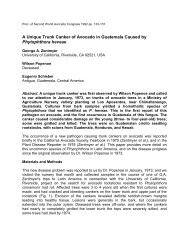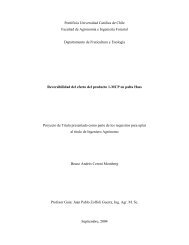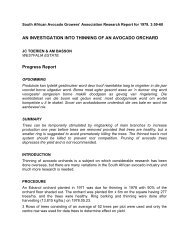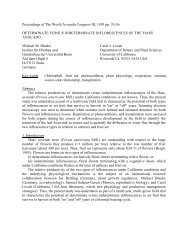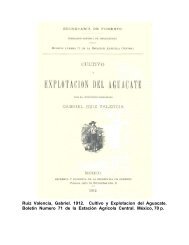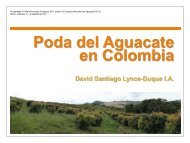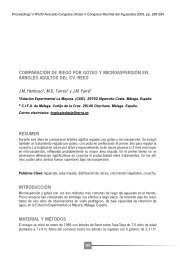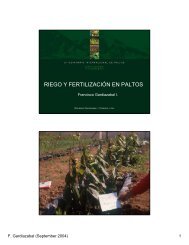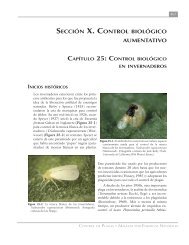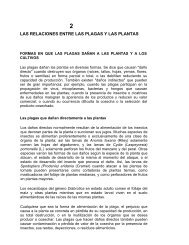Dothiorella Canker Disease of Avocado in California
Dothiorella Canker Disease of Avocado in California
Dothiorella Canker Disease of Avocado in California
Create successful ePaper yourself
Turn your PDF publications into a flip-book with our unique Google optimized e-Paper software.
old diseased avocado tree branches. Sequenced<br />
rDNA fragments (ITS1, 5.8S rDNA, ITS2,<br />
amplified with ITS4 and ITS5 primers) were<br />
compared with sequences deposited <strong>in</strong> GenBank.<br />
Fig 4. <strong>Dothiorella</strong> perennial canker on trunk<br />
Pathogenicity tests were conducted <strong>in</strong> the<br />
greenhouse on 1-year-old avocado seedl<strong>in</strong>gs, Hass<br />
cv., with one randomly chosen isolate from each <strong>of</strong><br />
the Botryosphaeriaceae species noted above. Four<br />
replicate seedl<strong>in</strong>gs were stem-wound <strong>in</strong>oculated<br />
with a mycelial plug and covered with Parafilm.<br />
Sterile PDA plugs were applied to four seedl<strong>in</strong>gs as<br />
a control. Over a period <strong>of</strong> 6 months, seedl<strong>in</strong>gs were<br />
assessed for disease symptoms that <strong>in</strong>cluded<br />
brown<strong>in</strong>g <strong>of</strong> leaf edges and shoot dieback. Mean<br />
vascular lesion lengths on stems were 64, 66, 64,<br />
and 18 mm for B. dothidea, N. parvum, N. luteum,<br />
and N. australe, respectively. Each fungal isolate<br />
was consistently reisolated from <strong>in</strong>oculated<br />
seedl<strong>in</strong>gs, thus complet<strong>in</strong>g the pathogenicity test.<br />
To our knowledge, this is the first report <strong>of</strong> N.<br />
australe, N. luteum, and N. parvum recovered from<br />
branch cankers on avocado <strong>in</strong> <strong>California</strong>.<br />
Fig 6. Leaf scorch symptoms <strong>of</strong> <strong>Dothiorella</strong> canker<br />
Fig 5. Stem end rot symptom <strong>of</strong> <strong>Dothiorella</strong> pathogens<br />
These results are significant because<br />
Botryosphaeriaceae canker pathogens are known to<br />
enter the host plant through fresh wounds (prun<strong>in</strong>g,<br />
frost, and mechanical). With high-density plant<strong>in</strong>g<br />
becom<strong>in</strong>g more common, which requires <strong>in</strong>tensive<br />
prun<strong>in</strong>g, the transmission rate <strong>of</strong> these pathogens<br />
could <strong>in</strong>crease <strong>in</strong> <strong>California</strong> avocado groves. The<br />
Eskalen laboratory is currently <strong>in</strong>vestigat<strong>in</strong>g<br />
control measures for dothiorella canker and stemend<br />
rot pathogens.<br />
Refernces:<br />
V. McDonald, S. Lynch, and A. Eskalen. 2009.<br />
First report <strong>of</strong> Ne<strong>of</strong>usicoccum australe, N. luteum,<br />
and N. parvum associated with avocado branch<br />
canker <strong>in</strong> <strong>California</strong>. Plant <strong>Disease</strong>. V.93, No.9.<br />
p.967.<br />
Pedro W. Crous, Bernard Slippers, Michael J.<br />
W<strong>in</strong>gfield, John Rheeder, Walter F.O. Marasas,<br />
Alan J.L. Philips, Artur Alves, Treena Burgess, Paul<br />
Barber and Johannes Z. Groenewald. 2006.<br />
Phylogenetic l<strong>in</strong>eages <strong>in</strong> the Botryosphaeriaceae.<br />
Stud. Mycol. 55:235.<br />
F. F. Halma and G. A. Zentmyer. 1953. Relative<br />
Susceptibility <strong>of</strong> Guatemalan and Mexican avocado<br />
varieties to <strong>Dothiorella</strong> <strong>Canker</strong>. Calif. <strong>Avocado</strong> Soc.<br />
Yearb. 38:156.<br />
W. F. T. Hartill and K. R. Everett. 2002. Inoculum<br />
sources and <strong>in</strong>fection pathways <strong>of</strong> pathogens<br />
caus<strong>in</strong>g stem-end rots <strong>of</strong> ‘Hass’ avocado (Persea<br />
americana) New Zealand Journal <strong>of</strong> Crop Hortic.<br />
Sci. 30:249.



